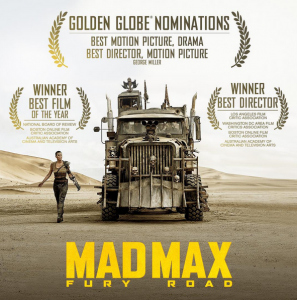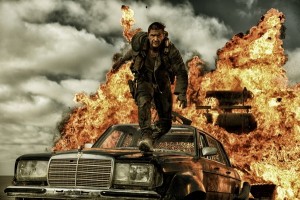
This post is the first film review in the series “Virtue Ethics at the Movies.” You can read the introduction to the series here.
*Contains spoilers. Do not read unless you have already seen the film or you don’t mind spoilers.
Mad Max: Fury Road is the fourth Mad Max film, and is directed by George Miller. Like the first three films, this one explores themes of societal decay and the heroism of everyday people in a violent world. And, yes, there are lots of action-packed chase scenes with big explosions and lots of crashes. But what I most appreciated about it is that it demonstrates that action films can have substance. It takes the genre of action film to a different level, adding complex themes of justice and redemption.
I’m a dialogue person. And this film doesn’t have much dialogue. (I joked that my film review is longer than the screenplay.) But when people do have something to say, religious imagery abounds: Hope, Redemption, Brokenness, Fall, Blood, Life, Death, Curse, Witness, Prayer, Self Sacrifice.
The Plot
Here’s the overview. The landscape—desert, dry, dirty. A society clearly stratified with ‘haves’ and ‘have nots.’ A ruling class, led by Immortan Joe, whose ‘war boys’ don white body paint and hypermasculine aggressive rage in their cult-like worship and obedience of Joe (who, by the way, does a great job of branding himself as master of strength while his body is overrun with tumors and is grotesque and scary both with and without his costume). No one is flourishing. Three desert communities hoard different scarce resources (gasoline, water, ammunition). Immortan Joe, patriarch of the Citadel, has a harem of women he keeps as ‘breeders’—some used to procreate, some used to make milk. They are sexual slaves. He also controls the water—life—but is in need of gasoline. So he sends Imperator Furiosa (Charlize Theron) on a ‘war rig’ to trade breastmilk for gas. Furiosa has other plans.
Mad Max (played by Tom Hardy), the film’s namesake, is a loner with a conscience. He keeps having flashbacks so we know he is dealing with deep suffering in his past—something to do with vulnerable children, presumed dead. He is clearly focused on his own survival, and he is tough, but in the beginning he is captured and as the plot begins to unfold Max is being used as a “blood bag” to keep alive one of Immortan Joe’s war boys, Nux.
In the world of the film, there is no such thing as paradise. There is no stability. A pacifist doesn’t stand a chance. Life is messy, and to survive you will have to join the fight. But what are you fighting for? And with whom?
Furiosa has a mission to liberate the captive breeders. Max becomes her partner in the struggle—not because he chose to but because in the circumstances the alliance makes the most sense. They have a common enemy (Immortan Joe and his war boys), so Furiosa and Max become partners. But to sum up the plot: Furiosa and Max go from Point A to Point B and then back to Point A and a lot of people die along the way.

Feminist Themes in Fury Road
Most would say that Mad Max: Fury Road is a far-fetched dystopia bearing little resemblance to the everyday life of American viewers. But just last week, the Los Angeles Times reported on a three-day sting operation that led to the discovery of twelve victims of sexual slavery in Los Angeles. In 2015, 949 human trafficking cases were reported in California, according to the National Human Trafficking Resource Center. More than 3,800 victims were discovered in human trafficking in the state since 2007.
So while the chase-and-crash scenes in Mad Max are full-throttle popcorn-munching action flick material, the story of sexual slavery is the brutal reality for thousands of US residents. I live in San Diego—one of the sex trafficking corridors of the world. And as a feminist, I found myself both appreciative of George Miller’s willingness to include these issues of gender violence in his film’s story, but ultimately unsatisfied by the way in which these complex themes were treated.
As you may already be aware, there has been much online discussion about whether Mad Max: Fury Road is a real feminist film. Those who argue that the film is feminist will point to the strong portrait of Furiosa, a determined woman willing to risk all to liberate the oppressed breeders, and to the wise Vuvalini women who protect the seeds and then become the hope-bearers for a future of life, as well as the breeders themselves, who escape but leave behind the message “We are not things.” According to this argument, Mad Max is a feminist film because it shows a strong female protagonist who leads a revolution against the patriarchal warlord and is ultimately successful. And while Charlize Theron is one of the most beautiful actors of our time, in this role she is disfigured, with a shaved head and greased up face: she is successful not because of her beauty but because of her courage and strength. She releases a revolution against the warlord Joe who has put himself at the top of the hierarchy and sees women’s value only in how their power of reproduction can serve his interests.
But not all critics agree that this is a feminist film. Let’s start with the scene in which Max first meets the breeders.

Anthony Lane of the New Yorker explains: “Our first glimpse of them bodes ill: limber beauties, draped in muslin underwear and hosing themselves down in the middle of nowhere. It’s like the start of a Playboy shoot.” Maria Bustillos adds: “the harem girls are so young, shapely and lovely and so scantily clad that they resemble nothing so much as a herd of supermodels waiting around for Steven Meisel.” In other words, the striking beauty of the women seems to undercut the feminist agenda of the film in that the women remain the objects of male desire (both in the film itself and in the audience’s reaction to the scene). The breeders are damsels in distress, in need of the male hero Max to come and save them. A.O. Scott of the New York Times argues that the women “evolve from eye candy into a feminist guerilla force.” But would a real feminist movie even have women as “eye candy” at all? Anita Sarkeesian argues that the film cannot be considered feminist: “Fury Road is different from many action films in that it lets some women participate as equal partners in a cinematic orgy of male violence.” But “feminism doesn’t simply mean women getting to partake in typical badass ‘guy stuff’.” Ultimately, Sarkeesian does not believe that Fury Road moves beyond the “glorification of violence.”
Maria Bustillos believes that Sarkeesian has overstated her case, and that the real feminist message of the film is not that it portrays women victorious over men but rather that good triumphs over evil: Furiosa and Max together, as partners, put an end to the reign of the patriarchal master Joe. “It’s a movie about how men and women can be not just ‘allies’ to one another, as if our fates were separate, but real comrades, who must overthrow a common enemy and share a common fate.” Bustillos concludes her argument by saying that what director Miller “is really doing is teaching men, not only women, how to rise above the patriarchy.”
And I want to agree with her. But here is where the ending of the film leaves me dissatisfied. Because in the end, Max just leaves. He doesn’t actually partner with Furiosa and the liberated women survivors to transform the Citadel into a place of social justice. He remains a loner, a hero with a past who chooses to leave even the community of women he helped to save (think here of the archetype in western films, the cowboy as reluctant hero with a heart for justice who wants to go it alone). Max gives a head nod to Furiosa just before he walks away into the crowd, and the last shot is of Furiosa being elevated to safety. What are we to make of such an ending? My interpretation is that Max leaves the women to do the work of rebuilding. But I think that for Max to be truly virtuous—redeemed—at the end of this film, he can’t remain a loner. He has to rejoin society, and work out the pain of his past and present with other people by striving to make the community healthy and free and just. A real hero doesn’t walk away from that.

Glorifying Violence or Unmasking Evil?
The film is rated R because of violence and partial nudity. So the film is intended for mature audiences. And I expect that many fans of the film love it for its brilliant action sequences and cinematography. The scenes of the Polecats fighting in the middle of a full speed chase scene is itself a masterful feat of acrobatics as impressive as any Cirque du Soleil show.
Some might argue that violent films such as this one glorify violence. But in this story, violence is not the end itself. A good dystopian film invites the audience to reflect on current injustices that, if unaddressed, will lead to society to ruin. Certainly the patriarchy of Immortan Joe is a key theme of the film, as noted earlier. (A particularly gruesome scene demonstrates his favoritism for boy children over girls). But another key theme in the film is the danger of religious fundamentalism and mindless conformity. Joe tells his war boys “I am your redeemer!” and they are willing to do anything to fight for him, even to the point of suicide missions—“Witness!” “I live, I die, I live again!” Is Miller commenting on religious fundamentalism in our own day? Perhaps. The war boys do not have individual identities as complex human subjects. Rather, they are cogs in the war machine of the empire. When the war boys—who only ever yell at each other—want to steel themselves for self-sacrifice, they spray their teeth with silver paint, which becomes a mask of sorts, further shielding their personal identity as they become willing to subsume their own self-interest to die with honor in Joe’s fight. The war boys engage in no critical thinking and ask no questions. They do their part in a fight they don’t control. So in some sense, the violence of the film is not just a commentary on religious fundamentalism but also on mindless militarism in general. Nux is the only war boy whose story has complexity, in that he feels shame, regret, and eventually solidarity with the women. Maria Bustillos reads the film as a political allegory, and interprets Nux as representing “all the patriotic young kids who enlisted after 9/11 and then were hurt and disillusioned and ruined and disfigured in the eternal wars.” I’m not sure the film is so straightforward, but she has a point. On the one hand, Furiosa is clearly justified in using force against the women’s captors. But on the other hand, the use of force is not a good in itself. (As in Catholic teaching, it is only justified when the aim is to secure the peace.) Max, Furiosa, and Nux are converted by the suffering of others to work in solidarity to overthrow an unjust ruler, and in order to do that they must reject mindless conformity and find inner strength and courage. In our current election cycle and mind-numbing cable news coverage of Trump, a message of nonconformity is welcome.
Conclusion
Ultimately, Mad Max: Fury Road raises important questions about the virtuous person and a stable social order. The role models of the film are courageous in their fight to make their world a better place. The villain’s power is not glamorized but is rather exposed as grotesque and foolhardy.
The film ends with a quote about being “in search of our better selves,” which is aligned with a virtue ethics approach to moral life as a journey toward wholeness and freedom. The film is far superior to the Fast & the Furious franchise and similar action films in the genre, and it borrows from the traditional western as well, but I think my frustration with the ending of the film is because I want to see more than action. Perhaps that is unfair. I think Miller would say that the drama of reconstructing society is not as interesting to him as the conflict that unfolds in a frightening world when good people have to stand up for what is right. Mad Max: Fury Road is a genre film, and so there are limits to the depth it can go. I applaud the filmmakers for even introducing the complex subjects they do, and one can’t expect an action film to tackle issues of sexual violence, militarism, and religious fundamentalism with the same kind of clarity and depth that a documentary can. Still, Mad Max: Fury Road is an impressive cinematic experience and is worth seeing and worth talking about.





Stumbled onto your article while searching for Mad Max Fury Road and Theology of Escape. Interesting. It’s a fantastic film full of rich symbolism including numerous allusions to the book of Revelation. I believe the film is about the battle of the sexes told in and through allusions to fall of Genesis 3 and the restoration of the sexes in through the sacrificial death of the ideal man. Here’s a short video I put together https://youtu.be/iaaOktcdkHw . Thanks for discussing a great film.